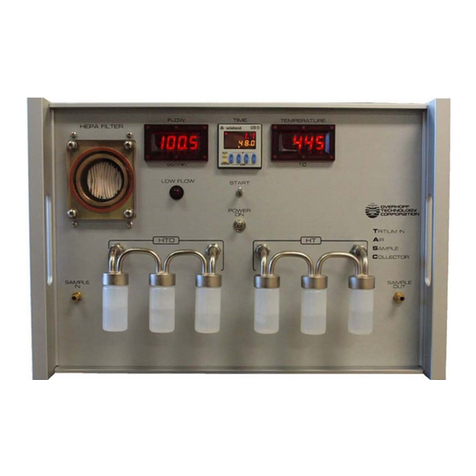
2
1.0. GENERAL DESCRIPTION
This tritium monitor consists of dual 2-liter ionization chambers with an integral
electrometer coupled to the electronic circuits for display and control inside one fiberglass
reinforced plastic molded enclosure suitable for wall mounting.
One ionization chamber, referred to as the measurement or upstream chamber,
measures in a positive manner. The second ionization chamber, referred to as the
compensation or downstream chamber, is identically constructed but subtracts from the
measurement of the upstream chamber. This is how dual chambers serve to cancel the
effects of external gamma fields and provide differential measurements.
Ionization chambers respond not only to the airborne radioisotope, which circulates
through the ionization chamber, but also respond to the presence of external high-energy
radiation capable of ionizing the air inside. Therefore, ionization chambers will respond
to X-rays and gamma radiation as well. Additional gamma radiation suppression can be
accomplished by using lead shielding. The electrometer serves to transform this current
into a form and magnitude suitable for display, alarm, and external uses, as the ionization
current itself is very weak.
The monitor contains all signal processing, alarm and external interface circuits, read out,
and all required power supplies. The signal processing circuits serve to reject unwanted
signals and to translate the electrometer signal voltage into a form and magnitude
suitable for display, alarm and external uses as well.
The alarm circuits provide a visual signal and relay outputs for remote connection to
denote that a preset level of measurement has been exceeded or certain malfunctions.
2.0. PHYSICAL DESCRIPTION
The Model Triathalon-H3 is a single range, ionization chamber monitor for the measurement
of tritium in a NEMA 4X enclosure suitable for permanent installation and for continuous duty.
The enclosure has a hinged door with a polycarbonate window. Behind the hinged door is a
front panel that is hinged so that it can be opened for servicing the various components
inside. The sample inlet and exhaust fittings are located on the left side of the enclosure.
Fittings for Tritium and Total Tritium measurement are located on the right side of the
enclosure. Wiring conduit connections are provided on the bottom of the enclosure and
consist of AC power conduit and control wiring conduit.
The following are located on the front panel:
Fuse holder, main power switch, ‘ON’ and ‘OFF’ indicators.
An LCD color touch screen serves the majority of control and display functions. These
include the tritium measurement, alarm set points and indication.
A 0-10 LPM adjustable flowmeter to indicate and control the sample flow.
The following are attached to the enclosure subpanel inside the enclosure:
Dual 2 liter ionization chamber;
Sample pump, differential pressure switch used for sensing a low flow condition, and all
DIN rail mounted electrical connections.
The following are located on the outer left side of the enclosure:
Stainless steel tubing connections for sample inlet and exhaust
HEPA filter for downstream sample stream.
The following are located on the outer right side of the enclosure:
Hose connections for a desiccant column used for noble gas compensation mode
HEPA filter for downstream sample stream.





























